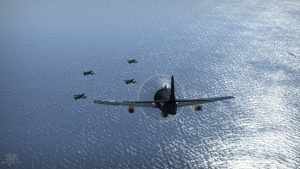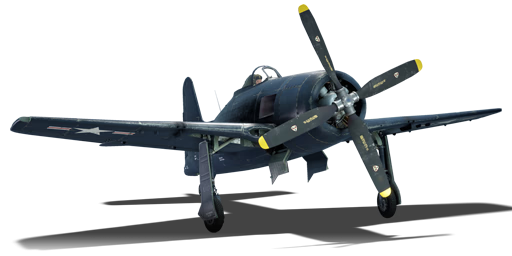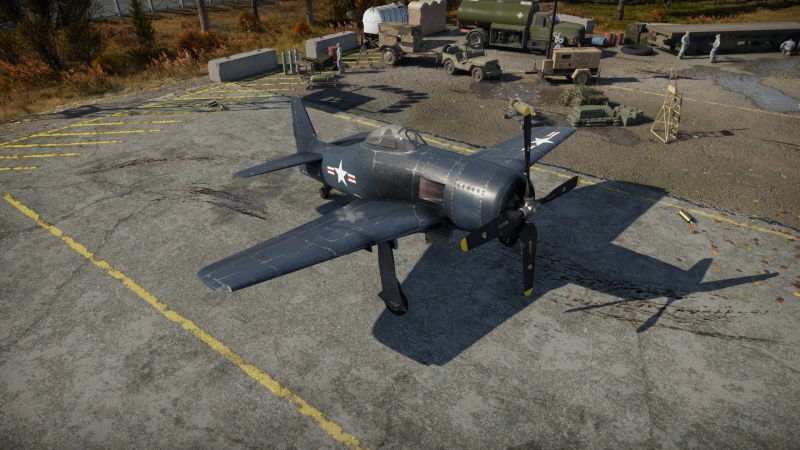F8F-1
| This page is about the American fighter F8F-1. For other variants, see F8F (Family). |
Contents
Description
The F8F-1 Bearcat is a rank III American naval fighter with a battle rating of 4.3 (AB), 4.7 (RB), and 6.0 (SB). It was introduced in Update 1.33.
The F8F-1 is an all-purpose light fighter-bomber, and excels as such. Although it may seemed incredibly outgunned with only four M2 Brownings, the Bearcat can be a more than decent fighter in the right hands. The plane was developed to achieve two things: the best possible climb rate and the ability to land on escort carriers.
The in-game F8F-1 retains many advantages of the real-life counterpart. The F8F has very good acceleration and climb rate, thanks to its powerful engine. Because of that, it can quickly gain an altitude advantage over its opponents. Thanks to its high top speed, good wing endurance, and good energy retention capabilities, the F8F is perfectly suited to energy fighting. A Bearcat pilot should avoid low-speed dogfights, instead opt for a diving attack from above.The Bearcat is also a very hardy aircraft able to sustain several hits from enemy cannon and machine gun rounds before being decommissioned. The phrase "Grumman Ironworks" comes into play on the Bearcats just like their previous works; The F3F, The F4F Wild Cat, and the F6F Hellcat. Therefore you shouldn't be too wary of 13-15 mm. 20 mm Hispanos and 30 mm Rhein Borsig series guns are your biggest threats in terms of damage.
The main issue with the F8F-1 is its armament. With only four 12.7 mm M2 machine guns, the F8F-1 is lacking especially when compared to the succeeding F8F-1B that has four 20 mm M3 autocannons. With a relatively low fire rate and low damage, pilots must make their shots count. Unlike most other planes equipped with the M2 Brownings, the Bearcat can utilize M20 API-T rounds. These rounds excel at setting targets aflame. Precise aiming is key, specifically targeting the enemy aircraft's engine or pilot. Aiming for the fuselage is less effective as unlike the P-47D, which has eight M2s which can chew through aircraft fuselages by hurling twice as many bullets down range. Meanwhile the measly 4 x M2s Bearcat will pepper the hull and simply be absorbed. And unlike other Browning armed airplanes, it has mediocre ammo load of only 1250 rounds.
Make use of the secondary payloads as well. The Bearcat can make use of the Tiny Tim rockets as well as a large array of HVAR rockets and bombs. Tiny Tims are especially useful against heavy ground targets and tanks.
General info
Flight performance
| Characteristics | Max Speed (km/h at 6,098 m) |
Max altitude (metres) |
Turn time (seconds) |
Rate of climb (metres/second) |
Take-off run (metres) | |||
|---|---|---|---|---|---|---|---|---|
| AB | RB | AB | RB | AB | RB | |||
| Stock | 650 | 626 | 10900 | 21.1 | 21.8 | 17.0 | 17.0 | 220 |
| Upgraded | 731 | 686 | 19.0 | 20.0 | 30.7 | 22.6 | ||
Details
| Features | ||||
|---|---|---|---|---|
| Combat flaps | Take-off flaps | Landing flaps | Air brakes | Arrestor gear |
| ✓ | ✓ | ✓ | X | ✓ |
| Limits | ||||||
|---|---|---|---|---|---|---|
| Wings (km/h) | Gear (km/h) | Flaps (km/h) | Max Static G | |||
| Combat | Take-off | Landing | + | - | ||
| 827 | 340 | 616 | 585 | 427 | ~10 | ~5 |
| Optimal velocities (km/h) | |||
|---|---|---|---|
| Ailerons | Rudder | Elevators | Radiator |
| < 465 | < 466 | < 600 | > 460 |
| Compressor (RB/SB) | ||
|---|---|---|
| Setting 1 | ||
| Optimal altitude | 100% Engine power | WEP Engine power |
| 995 m | 2,299 hp | 2,384 hp |
| Setting 2 | ||
| Optimal altitude | 100% Engine power | WEP Engine power |
| 5,090 m | 1,852 hp | 1,918 hp |
Survivability and armour
- 8.5 mm Steel - Under cowling engine armour plate
- 8.5 mm Steel - Fore cockpit protection plate
- 9.5 mm Steel - Pilots seat and headrest
- 60 mm Bulletproof glass - Windshield
Modifications and economy
- The "holy trinity" of flight performance upgrades: Compressor, Engine, and Engine injection. All three combined increase climb rate by 10 m/s (~2,000 feet/min)
- Armament upgrades are worth considering due to lacking armament, bad stock belts and mediocre ammo count
- G-suit is very useful, given the plane is most manoeuvrable at medium to high speeds
Armaments
Offensive armament
The F8F-1 is armed with:
- 4 x 12.7 mm M2 Browning machine guns, wing-mounted (300 + 325 rpg each wing = 1,250 total)
The M2 Browning machine gun by this rank is a very familiar machine gun to most American players. The usage of the M20 API-T rounds in the belts available makes the F8F-1 able to dish out similar damages to that of other Rank III-IV fighters with the M2 Browning armaments.
However, the mounting of the armaments on the F8F-1 has some downsides. The F8F-1 only comes with four machine gun totals, two per wing, compared to the usual six machine guns in American fighters. Not only that, the F8F-1 guns come with less rounds per gun in the wing. This means the F8F-1 overall loses out in firepower and firing time available with the click of the trigger.
Suspended armament
The F8F-1 can be outfitted with the following ordnance:
- Without load
- 4 x 12.7 mm M2 Browning machine guns, wing-mounted (gunpods) (340 rpg = 1,360 total)
- 2 x Tiny Tim rockets
- 4 x HVAR rockets
- 1 x 1,000 lb AN-M65A1 bomb + 4 x HVAR rockets (1,000 lb total)
- 1 x 1,000 lb AN-M65A1 bomb (1,000 lb total)
- 1 x 1,000 lb AN-M65A1 bomb + 2 x 500 lb AN-M64A1 bombs (2,000 lb total)
- 3 x 1,000 lb AN-M65A1 bombs (3,000 lb total)
In modes outside of Arcade Battles, the F8F-1 releases some suspended armaments in pairs rather than singular. The Tiny Tim rockets are both fired at the same time, so the pilot will only have one chance to hit the target. In configurations with multiple bombs, the wing-mounted bombs drop off first before the fuselage-mounted bomb.
Usage in battles

This aircraft is best when used as an energy fighter; however, unlike other American planes, it doesn't fulfil the Boom-and-Zoom role very well because of lacking armament and rudder lock-up above 720 km/h.
Originally designed to achieve best possible climb rate, this aircraft sacrifices almost everything else, including armament, supercharger, fuel load and radiator. However, as it was also made to be able to use escort carriers, it is also small and durable.
This aircraft has great climb rate in Air Realistic Battles (spaded and with minimum fuel) as well as great acceleration; these two traits should be used accordingly for the plane's best performance. At the beginning of the match, climb into the battlefield, and attack the opponents with the highest energy. If there is an enemy above you, disengage using your great acceleration. Do not be afraid to attack lower enemies, as this plane's optimal altitude is below 1,000 m. It is also quite fast in a straight line, especially on low altitudes.
The bad low speed manoeuvrability isn't really an issue given the plane's acceleration.
Manual Engine Control
| MEC elements | ||||||
|---|---|---|---|---|---|---|
| Mixer | Pitch | Radiator | Supercharger | Turbocharger | ||
| Oil | Water | Type | ||||
| Controllable | Controllable Not auto controlled |
Controllable Not auto controlled |
Controllable Auto control available |
Separate | Controllable 2 gears |
Not controllable |
- Although the name "Ovencat" may not sound encouragingly, MEC lets pilot completely forget about the overheating problem. Set the prop pitch to 100%, Mixer to ~95%. Change supercharger gear around 1,100 m. Manage radiators according to the temperatures.
Pros and cons
Pros:
- Great climb rate
- Great acceleration
- Good top speed, especially at low altitudes
- Great turn rate at medium to high speeds
- Good roll rate at higher speeds
- G-suit modification
- Fast weapon reload (AB)
- Great energy retention in the vertical
- Can take a punch
- Can utilize M20 API-T belts, which can set everything on fire with only a couple of bullets
- Has access to gunpods
- Has carrier hook which makes it useful on Pacific maps
- It doesn't see jets as often as the F8F-1B
Cons:
- Sluggish low speed handling (roll rate) and turning
- Loses a lot of energy when turning
- Bad high altitude performance above 5,000 m
- Rudder compresses hardly when speeding above 720 km/h
- Engine overheats on 100% when using auto controls
- Limited supply of ADI (Anti-Detonant Injection - mixture of alcohol and water to boost performance for WEP)
- Extremely poor weapons when compared to Fw-190, J2M, Spitfire, and Yak variants, among others
- Limited ammo count
History
The first idea for the creation of the Grumman F8F Bearcat was pitched after the Battle of Midway. Many pilots who took part in it remarked that one of the most important parts of naval air warfare was an aircraft's rate of climb. This of course meant that an increase in power was necessary. In 1943 the design work on the new aircraft began. The outline called for a fighter-interceptor, capable of operating even from small escort carriers. While the engine – the Pratt & Whitney R-2800 radial – was the same model used on the earlier F6F Hellcat, the new fighter would be lighter which also meant an increase in speed and climb rate. The concession was limiting the range of the new aircraft. The F8F would also feature a bubble canopy for better all around visibility. The first prototype, the XF8F-1, first took to the skies on the 21st August 1944. Further tests proved the aircraft's reliability and ruggedness, and the F8F was accepted into mass production. The first serial models rolled off the assembly line in February 1945 and were delivered to VF-19 fighter squadron, which began operating flights with the Bearcats in May 1945.
The new fighter, was, however, too late for any combat in World War II. After the war the situation of this propeller aircraft got even more complicated thanks to the introduction of naval jet aircraft. Even though the F8F was one of the fastest propeller-driven aircraft of its time, it was clear that the jet age was dawning. The F8F was replaced in US Navy and USMC service by the F9F Panther and the F2H Banshee jet aircraft. Some Bearcats saw combat service with the French in French Indochina in 1951, when they were used in the CAS role against the Viet Minh troops. Thailand also received a shipment of Bearcats which were then operated by the Thai Air Force. The F8F found a new life – thanks to its speed and acceleration - it was and still is widely used as a racing aircraft. One of the most famous racing Bearcats is the Rare Bear – a specially modified F8F, which holds many propeller aircraft speed and climb records.
Media
- Skins
See also
- Other F8F aircraft
External links
| Grumman Aircraft Engineering Corporation | |
|---|---|
| Aircraft | |
| Fighters | |
| F3F | F3F-2 · Galer's F3F-2 |
| F4F Wildcat | F4F-3 · F4F-4 |
| XF5F Skyrocket | XF5F · XP-50 |
| F6F Hellcat | F6F-5 · F6F-5N |
| F7F Tigercat | F7F-1 · F7F-3 |
| F8F Bearcat | F8F-1 · F8F-1B |
| Jet Fighters | |
| F9F Panther/Cougar | F9F-2 · F9F-5 · F9F-8 |
| F-11 Tiger | F11F-1 |
| F-14 Tomcat | F-14A Early · F-14B |
| Jet Strike Aircraft | |
| A-6 Intruder | A-6E TRAM |
| Bombers | TBF-1C |
| Export | ▄Martlet Mk IV · ▄F6F-5 · ▄F6F-5N · ▄F8F-1B · ▄Avenger Mk II · ▄Hellcat Mk II |
| ▄F-14A IRIAF | |
| Naval Vehicles | |
| Patrol Gunboat Hydrofoil (PGH) | USS Flagstaff |
| USA fighters | |
|---|---|
| P-26 Peashooter | P-26A-33 · P-26A-34 · P-26A-34 M2 · P-26B-35 |
| P-36 Hawk | P-36A · Rasmussen's P-36A · P-36C · ○P-36C · P-36G |
| P-39 Airacobra | P-400 · P-39N-0 · P-39Q-5 |
| P-40 | P-40C · P-40E-1 · P-40E-1 TD · P-40F-10 |
| P-43 Lancer | P-43A-1 |
| P-47 Thunderbolt | P-47D-22-RE · P-47D-25 · P-47D-28 · P-47M-1-RE · ⋠P-47M-1-RE · P-47N-15 |
| P-51 Mustang | P-51 · P-51A (Thunder League) · P-51C-10 · P-51D-5 · P-51D-10 · P-51D-20-NA · P-51D-30 · P-51H-5-NA |
| P-63 Kingcobra | P-63A-5 · P-63A-10 · P-63C-5 · ␠Kingcobra |
| Prototypes | XP-55 |
| F2A Buffalo | F2A-1 · Thach's F2A-1 · F2A-3 |
| BF2C | BF2C-1 |
| F3F | F3F-2 · Galer's F3F-2 |
| F4F Wildcat | F4F-3 · F4F-4 |
| F4U Corsair | F4U-1A · F4U-1A (USMC) · F4U-1D · F4U-1C · F4U-4 · F4U-4B · F4U-4B VMF-214 · F2G-1 |
| F6F Hellcat | F6F-5 · F6F-5N |
| F8F Bearcat | F8F-1 · F8F-1B |
| Other countries | ▃Ki-43-II · ▃Ki-61-Ib · ▃A6M2 · ▃Bf 109 F-4 · ▃Fw 190 A-8 · ▃Spitfire LF Mk IXc |





